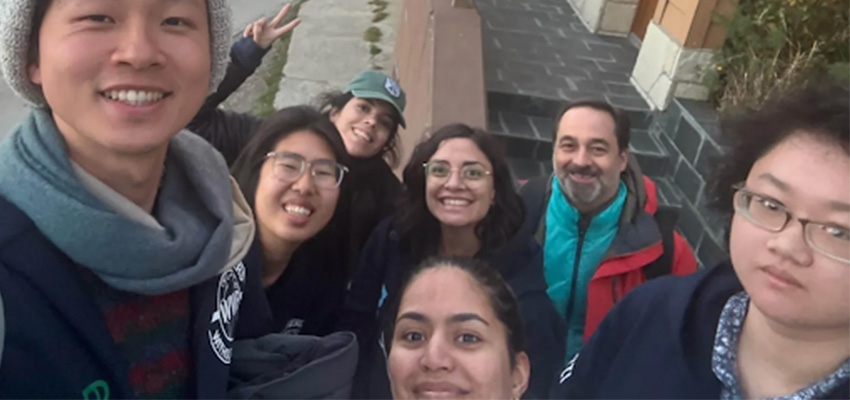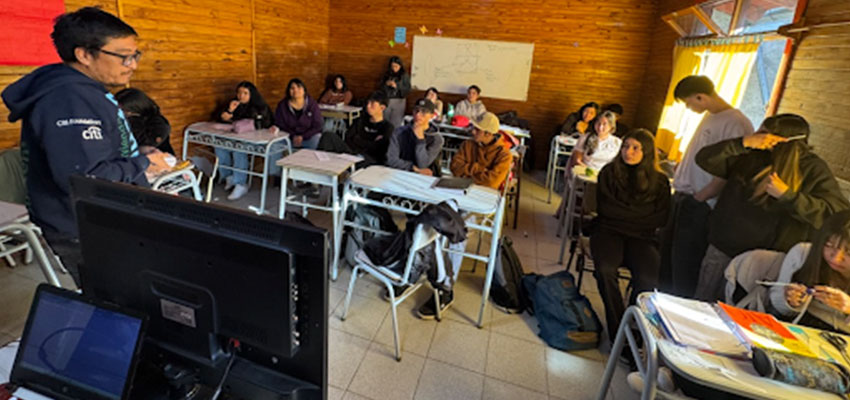
Throughout the MIT D-Lab course Introduction to Energy in Global Development (EC. 711), which we took in Spring 2025, we worked with the non-profit organization Weatherizers Without Borders (WWB) and its Argentina-based sister organization Fovisee Vivienda Justa (Fovisee) to develop a model house, which we can use to measure and demonstrate the effectiveness of weatherization techniques to lawmakers, academics, and residents in Argentina.
As the final part of the class, we went on a trip to Argentina. First, we arrived in Buenos Aires, where Fovisee is based, to meet with other students and academics in the field and share presentations and research.
Irene Dong, Kanokwan Tungkitkancharoen, Bob Zeng, and Chloe Smith (not pictured, and who did not go on the trip) are the students who worked on the Weatherization in Argentina project in spring 2025 with the guidance of WWB representative Nicolas Maggio (Nick). Irene (class of '27) and Kano (class of '26) are both mechanical engineering majors, while Bob is a (recently graduated) graduate student at the Sloan School of Management and Chloe (class of ;26) is an Urban Studies and Planning major. Khadija, a recent graduate student in the Department of Urban Studies and Planning, was the teaching assistant of the class and trip leader.
Presentations at Buenos Aires
We first arrived in Buenos Aires, where Fovisee is headquartered, where we spent the next few days discussing weatherization and performing live demonstrations of weatherization techniques to various researchers, academics, students, and others who work in the field of housing development.

The live demonstration involves placing temperature and air quality sensors both inside and outside the house. We can turn on heat lamps and use a thermal imaging camera to demonstrate the effectiveness of insulation, and light pieces of paper on fire inside the house to demonstrate the resulting dramatic decrease in air quality without proper ventilation.
Bariloche
At Bariloche, we had the wonderful experience of visiting several high schools in the area and giving their students presentations about the importance of air quality and carbon monoxide monitoring. All the presentations are of course in Spanish, and Bob Zeng, the only one of the D-Lab group who is fluent, was greatly involved in answering questions.

Assessing Jasmine’s house
The most important part of our trip was our regular, daily visits to Jasmine’s house. Jasmine is a young woman with a daughter, living in extreme poverty in one of Argentina’s many informal settlements. She built much of her house herself, despite a severe lack of materials or training. Due to extreme inflation and a lack of jobs, she does not have enough money to heat her house to livable temperatures every night for the upcoming winter. The main goal of our trip is to use modern weatherization techniques to assess the performance of Jasmine’s house, and then create a plan to maximize the improvement we could make with a budget of around 2000 USD, which is how much Fovisee can allocate.

This fireplace was originally the home’s main source of heat. We first placed temperature and air quality sensors around the house, which later confirmed the house temperature regularly hovered close to freezing. Both the water and electricity lines were aboveground–the thin water pipe was constantly leaking, and the electric wires were in some areas completely exposed. The two lines ran next to each other. The roof was being held down by bricks, or the wind would blow it off. The foundational pillars of the house were not properly installed and the entire place was in danger of collapsing in bad weather. This informal settlement also did not have a sewage system, so the toilet waste was flushed directly into a large pit dug outside the house (covered partially by a metal sheet).
We ran the blower door test, which generates a pressure difference between the inside and outside of the house and measures the volumetric flow rate to calculate how leaky the house is–and therefore, how much heat energy it is losing. Unsurprisingly, Jasmine’s house was over ten times leakier than what is standard.

Budgeting was difficult, and it was clearly impossible to fix everything that needed to be fixed. Nick cut out little strips of paper with a repair and a price attached to it, and we all took turns arranging them to what we felt would be best for Jasmine. Construction Workers would cost 700 USD. Fixing the electricity is 450 USD. Merely making the house structurally stable would be 300 USD. Adding full insulation? 400 USD. Not to mention fixing all the leaky holes, a wood stove, the lack of construction material…a bathroom renovation for a proper sewage treatment system would cost the entire budget.
After thinking it over and talking with Jasmine, the solution Fovisee went with was to make the house structurally stable, add insulation and Tyvek to just the roof, fix the electricity, buy a wood stove to replace her incredibly inefficient fireplace, and move the toilet from a much more exposed part of the house to a smaller bathroom created by adding a wall in the living room. To make this possible within the budget, Nick renegotiated with the construction contractors for a lower amount and had Jasmine ask some friends and relatives to help with the construction. Irene and Khadija also spent a bit of time digging the trenches for the electricity and water pipes to be buried, though the limiting factor ended up being not enough shovels instead of not enough people. Besides moving the toilet to a more convenient location, Fovisee could not afford to do anything else about the state of her sewage system–it will remain a hole outside her house for the foreseeable future.
Jasmine’s house was still undergoing renovation up to the last days we were in Argentina. When the roof was finished, we all celebrated with empanadas. It was good to see how greatly improved the house was in just a week’s time, but it was also troubling to look around the entire neighborhood, over the sprawling mountains that enveloped us, and see just how many people live in similar conditions and will have to face the incoming winter still fearing for their lives.
Many of these informal settlements began in the last 15 years, with masses of people with no other choice fleeing housing and economic crises in populated areas. There is little infrastructure, a severe lack of public service centers, and few jobs or economic opportunities. Until something drastic changes, organizations like Fovisee will continue to do what work they can to educate the public and improve the lives of individuals like Jasmine and her daughter. And we hope to continue, in the future, to support organizations like them.
More information
Introduction to Energy in Global Development
Contact
Joshua Paul Maldonado, MIT D-Lab Instructor

